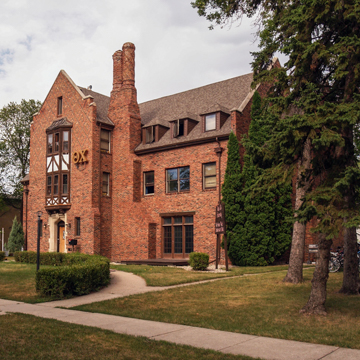The picturesque motifs of this three-story fraternity house draw from Tudor Revival. They include diagonal brick diapering, clinker brickwork, half-timbering, and heraldic references in the leaded glass and entrance surround. The exterior brickwork—rough and irregular at the ground line and progressively more refined as it rises to the top of the massive chimneys—has been portrayed in years of the fraternity chapter’s history as an architectural allegory for the growing perfection achievable during the time spent at the university. Tudor Revival was a style that Kurke explored on several projects, including the Hanna House (1925; 707 8th Street S) and an unusual little chapel/wellhouse (1942; 1502 32nd Avenue NW) at Holy Cross Cemetery.
You are here
Theta Chi Fraternity House
If SAH Archipedia has been useful to you, please consider supporting it.
SAH Archipedia tells the story of the United States through its buildings, landscapes, and cities. This freely available resource empowers the public with authoritative knowledge that deepens their understanding and appreciation of the built environment. But the Society of Architectural Historians, which created SAH Archipedia with University of Virginia Press, needs your support to maintain the high-caliber research, writing, photography, cartography, editing, design, and programming that make SAH Archipedia a trusted online resource available to all who value the history of place, heritage tourism, and learning.















